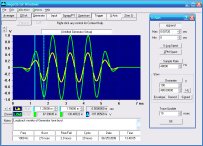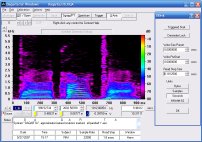![[LogoShip]](logo5.png)
Software for Windows
Science with your Sound Card!


Features:
Oscilloscope
Spectrum Analyzer
8-Channel
Signal Generator
(Absolutely FREE!)
Spectrogram
Pitch Tracker
Pitch-to-MIDI
DaqMusiq Generator
(Free Music... Forever!)
Engine Simulator
LCR Meter
Remote Operation
DC Measurements
True RMS Voltmeter
Sound Level Meter
Frequency Counter
Period
Event
Spectral Event
Temperature
Pressure
MHz Frequencies
Data Logger
Waveform Averager
Histogram
Post-Stimulus Time
Histogram (PSTH)
THD Meter
IMD Meter
Precision Phase Meter
Pulse Meter
Macro System
Multi-Trace Arrays
Trigger Controls
Auto-Calibration
Spectral Peak Track
Spectrum Limit Testing
Direct-to-Disk Recording
Accessibility
Data Logger
Waveform Averager
Histogram
Post-Stimulus Time
Histogram (PSTH)
THD Meter
IMD Meter
Precision Phase Meter
Pulse Meter
Macro System
Multi-Trace Arrays
Trigger Controls
Auto-Calibration
Spectral Peak Track
Spectrum Limit Testing
Direct-to-Disk Recording
Accessibility
Applications:
Frequency response
Distortion measurement
Speech and music
Microphone calibration
Loudspeaker test
Auditory phenomena
Musical instrument tuning
Animal sound
Evoked potentials
Rotating machinery
Automotive
Product test
Contact us about
your application!
Sampled Data for the Discrete Fourier Transform
Unlike the continuous Fourier Transform just described, the Discrete Fourier Transform (DFT) uses digital methods that allow computer inplementation. In place of a continuous input signal we will need sampled data from an Analog-to-Digital Converter (ADC). This device takes samples of the input signal at regular intervals and outputs a digital number proportional to the instantaneous voltage.
Here is an example of a sampled sine wave. The solid black squares mark the actual data samples:
The time between samples is called the sample period, and the rate of sampling is called (surprise!) the sample rate or sampling frequency. No information is available about what the input does between samples, so we must make sure that we sample often enough to adequately represent its behavior. In this example, the actual input sine is at 3 kHz, and the solid black squares mark the individual samples that result from sampling at 48000 samples per second. That sample rate is 16 times the signal frequency, so there are 16 samples per cycle. This allows a perfect reconstruction of the input from the data, as shown by the black curve.
Given only the sample values, the black curve could have simply been drawn "by eye" in a connect-the-dots fashion. In general, however, we must consider the sinusoidal nature of the signal. When there are few samples per cycle, a straight-line approximation would give a poor representation of the waveform. Nevertheless, an DFT analysis could provide the frequency, amplitude, and phase parameters needed to reproduce the input exactly.
What is the minimum sample rate that will accurately capture the details of an input signal? Or, given a certain sample rate, what limits are imposed on input signals if they are to be perfectly captured? The limits are determined by a phenomenon called aliasing.
See also Spectrum (Fourier Transform) Theory
- Back to Spectrum Analysis Frequency Resolution
- Ahead to Sampled Data Aliasing
- Daqarta Help Contents
- Daqarta Help Index
- Daqarta Downloads
- Daqarta Home Page
- Purchase Daqarta
Questions? Comments? Contact us!
We respond to ALL inquiries, typically within 24 hrs.INTERSTELLAR RESEARCH:
Over 35 Years of Innovative Instrumentation
© Copyright 2007 - 2023 by Interstellar Research
All rights reserved